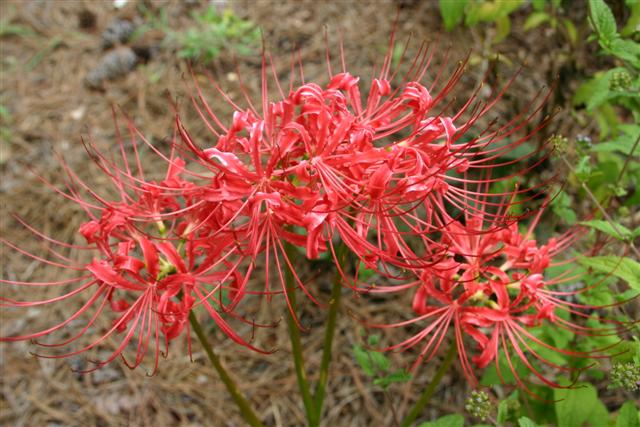Georgia Gardener Newsletter Cool Plant: September 4, 2008
| Spider Lily |
| Lycoris radiata
|

|
Need garden help?
Check out our Services.
|
Species Native Range: Asia
Hardiness: USDA Zones 7-10
Mature Size: 18-24 inches tall and 12 inches wide
Exposure: Full sun to medium shade
Soil: Average, well-drained
Drought Tolerance: Excellent
Ease of Culture: Easy
Spider lilies (aka hurricane lilies) are an unusual late summer/early fall flowering bulb. In September, leafless stalks
shoot up naked from the ground and produce scarlett red (or white, pink, etc.) clusters of spider-shaped flowers. During the blooming
phase there are no visible leaves on this plant. After the flowers have died and dropped away, thin strap-like leaves
will appear in the late fall that will persist to spring. The leaves disappear leaving no trace of the plant for
quite a few weeks until the flower stems appear.
Grow spider lilies in average to rich but well-drained soil in full sun to moderate shade. Interestingly, my plants are
in a full sun perennial bed yet the spider lilies growing at the
Atlanta Botanical Garden
are in a woodland setting. The plants appear to thrive and slowly spread in both environments. The trick is remembering
where they are planted during their dormant period (spring to late summer) so they aren't accidentally disturbed.
Use spider lilies in a bulb garden, perennial bed, woodland garden or in containers for late season color. The bulbs will
produce bulblets which should be dug and divided every few years. As a non-native, I would classify this plant
as slowly colonizing small areas but is not invasive.
Sources
Spider lilies can be purchased as dormant bulbs from a variety of catalogs or as potted plants from some local nurseries.
van Bourgondien: mail order
Park Seed: mail order
McClure & Zimmerman: mail order
White Flower Farm: mail order
Copyright © 2008 by Theresa Schrum - All rights reserved
No part of this website may be reproduced without the expressed written permission of Theresa Schrum

